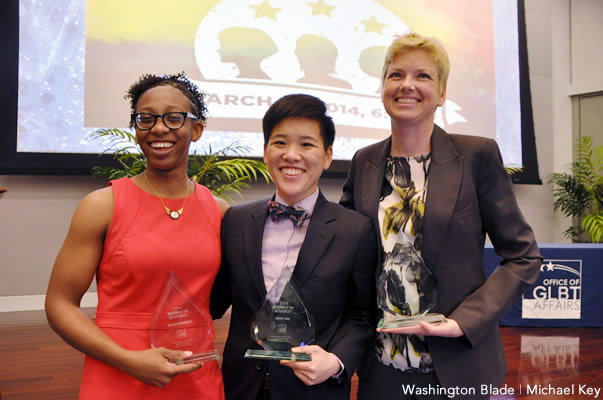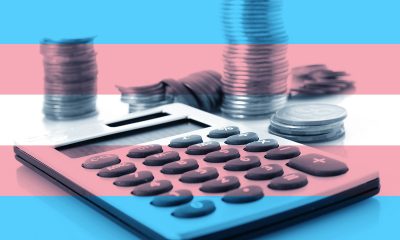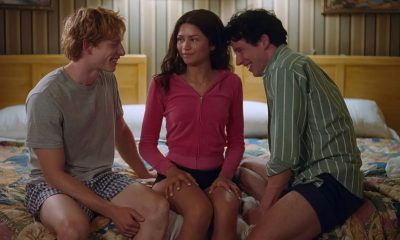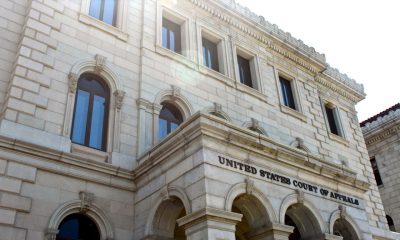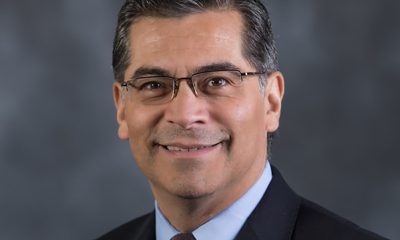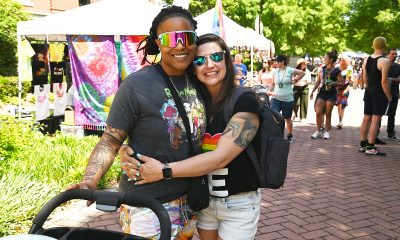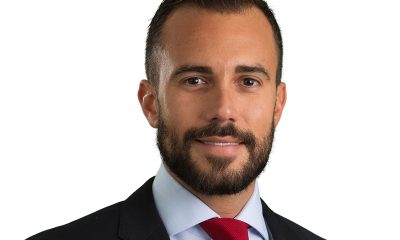homepage news
Gulf Coast’s LGBT residents mark Katrina anniversary
Recovery continues nine years after hurricane
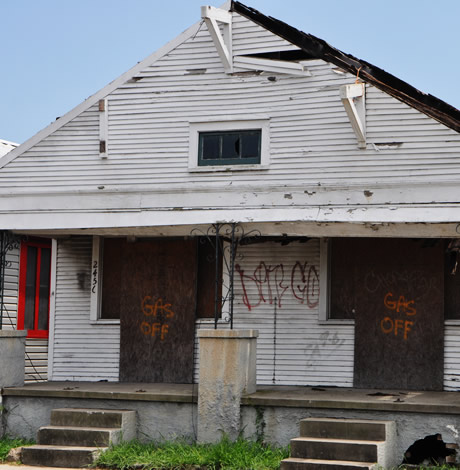
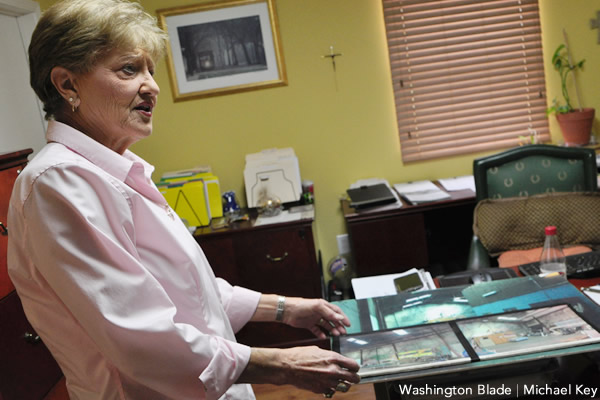
Belle Reve Executive Director Vicki Weeks shows photos of the hurricane damage to her organization’s building. (Washington Blade photo by Michael Key)
NEW ORLEANS — It was around 2 a.m. on Aug. 27, 2005, when Vicki Weeks, executive director of Belle Reve, a residence for people with HIV/AIDS in New Orleans’ Marigny neighborhood, and three of her staffers began to evacuate the Crescent City ahead of Hurricane Katrina with eight clients who had no other way to leave.
It took the group eight hours to drive three miles on Interstate 10 in New Orleans because of a massive traffic jam.
“We couldn’t move,” Weeks told the Washington Blade during an interview at her office last month. “Traffic was sitting and we were on a high-rise elevated expressway with no bathrooms, no water.”
The eight Belle Reve residents, along with Weeks and her three staffers arrived at a campground in Alexandria, La., 16 hours after they left New Orleans — the trip normally takes less than four hours. Weeks told the Blade she, her employees and residents immediately faced discrimination from the owners because many of them were of color.
“They harassed us every single day we were there,” said Weeks. “We were there 19 days looking for another place to go.”
Friday marks the ninth anniversary of Katrina’s landfall on the Gulf Coast.
A 28’ storm surge and winds that exceeded 125 mph in places devastated the Mississippi Gulf Coast. Up to 80 percent of New Orleans flooded after levees along the 17th Street, London Avenue and Industrial Canals failed.
More than 1,800 people in Louisiana, Mississippi and other states lost their lives during Katrina.
’Nothing recognizable’ on Miss. coast after Katrina
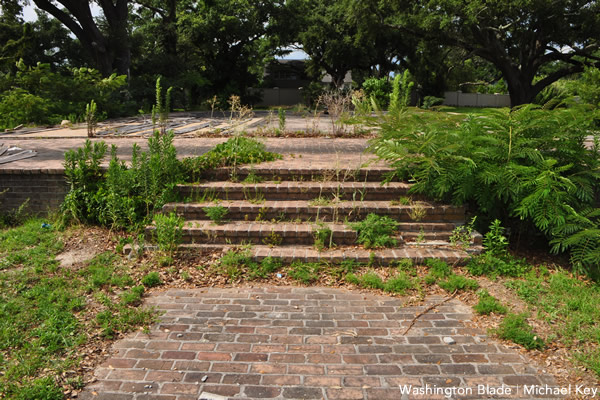
Hurricane Katrina destroyed rows of homes along the Mississippi Gulf Coast, leaving only foundations now overgrown with weeds. (Washington Blade photo by Michael Key)
Jena Pierce, a lesbian from Biloxi, Miss., and her two children evacuated their home in nearby Gulfport with her photo albums and things she told the Blade she “knew I’d never be able to see again.” They rode out the storm at the hospital where Pierce worked that is 30 miles inland.
Katrina’s storm surge destroyed Pierce’s home that was two houses away from the beach.
“There was really nothing recognizable,” Pierce told the Blade during a July 14 interview at Edgewater Mall in Biloxi that suffered extensive damage during the hurricane. “You couldn’t tell what street was what street. There were no landmarks for identifying where you were.”
Julie Thompson, co-president of PFLAG New Orleans, and her husband lived about a mile west of the 17th Street Canal in the Bucktown section of Metairie, La. Up to 17’ of water inundated the adjacent Lakeview neighborhood of New Orleans after a levee along the waterway that empties into nearby Lake Pontchartrain failed during the storm.
Julie Thompson evacuated to her daughter’s home in Austin, Tex., where she lived for six weeks after Katrina made landfall.
She told the Blade during a July 13 interview at a Metairie coffee shop near the 17th Street Canal that she quickly learned the fate of her home from the pictures her now daughter-in-law in the U.S. Coast Guard sent.
“We only had a little over a foot of water, but it destroyed everything,” said Julie Thompson. “We didn’t have anything left.”
The U.S. Census noted New Orleans in 1999 had a poverty rate of nearly 28 percent — and this figure was higher among people of color. More than 100,000 people in the Crescent City did not have access to transportation that would have allowed them to evacuate ahead of Katrina.
“The city did not have an evacuation plan for people with no vehicles, and that’s why so many people stayed,” said Weeks, who lives in New Orleans’ Gentilly Terrace neighborhood that was under several feet of water after Katrina. “We tried to get our residents to go with relatives or with churches, but we still had eight out of 12 that had no way to get out of town.”
Trinette Crump of the South Mississippi AIDS Task Force in Biloxi told the Blade during a telephone interview earlier this week that she made sure the handful of people who lived in her organization’s transitional housing program safely evacuated the coast ahead of Katrina.
She said local meteorologists had forecasted the hurricane would affect New Orleans and other areas more than the Mississippi Gulf Coast. Crump evacuated with her neighbor from their Gulfport apartment complex to her parents’ home in the Florida Panhandle hours before Katrina made landfall.
“I didn’t really figure out until like maybe 1 or 2 o’clock in the morning that this thing was really going to come towards this coast and not those other places,” she said.
Miss Eddie, a transgender woman who currently lives at Belle Reve, rode out the storm in the run-down house near the Esplanade Mall in the New Orleans suburb of Kenner that she rented with her best friend.
She told the Blade during a July 14 interview at Belle Reve that she initially didn’t even realize her home was flooded when she stepped into 15” of water while walking to the bathroom.
“When I got in bed I said ‘oh, my feet are wet,’” said Miss Eddie. “I took a towel and I dried my feet. As I was putting them back into the bed, my foot hung out again. I said ‘oh damn,’ so I wiped it again and then it did it again. I said ‘wait a minute, we’re in a flood.’”
The street on which Miss Eddie’s home was located was under nearly three feet of floodwater after Katrina.
Members of the National Guard and volunteers brought them food, water and cigarettes because supermarkets and other local businesses were closed. Miss Eddie’s mother and her best friend both became sick after the storm, but she described her home as “blessed.”
“They wanted to kill each other and I was oblivious to the whole thing due to the flood and everything,” Miss Eddie told the Blade. “So we had a rough time during the Katrina with my mother.”
Excerpts of interview with Miss Eddie
Hurricane prompts some to permanently leave Gulf Coast
Those who had the means to do so temporarily relocated from New Orleans and the Mississippi Gulf Coast.
The home in which Johanna Williams and her family lived in New Orleans’ Upper Ninth Ward had more than 4’ feet of water inside of it after the storm. Nearly 8’ feet of water flooded her grandparents’ home.
Williams, who was 15 during Katrina and had come out to her friends weeks before the storm made landfall, lived with her family in Memphis for seven months after the hurricane. She joked she attended a school that was “in the middle of cotton fields.”
Williams told the Blade she was able to celebrate Christmas Eve in her family’s home because her father, who was a fire captain for the New Orleans Fire Department at the time, was able to repair it enough.
“The second the waters receded he was gutting out our house so we could actually have our house available to us,” said Williams. “We were one of the few people who were able to come back.”
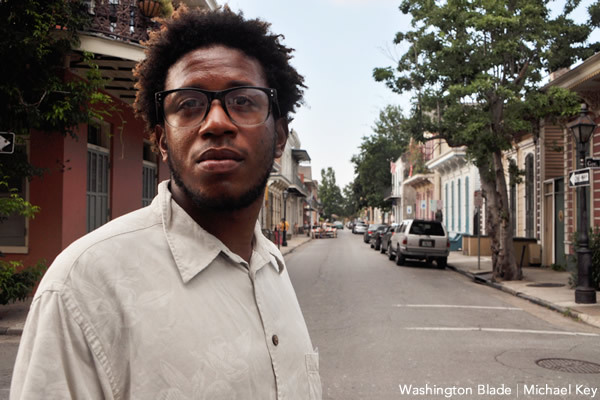
Timothy Thompson (Washington Blade photo by Michael Key)
Timothy Thompson, a peer educator with the New Orleans AIDS Task Force, evacuated the house in Slidell, La., in which he lived with his mother, grandmother and sister. They lived in a two-bedroom apartment with his family in Baton Rouge, La., for six months after Katrina before Timothy Thompson enrolled in Southern University.
Timothy Thompson’s family had to “pretty much gut” their home in Slidell because of the floodwaters and mold that followed. He told the Blade that he and his family “found strength” by volunteering at Louisiana State University and through “giving back by helping out” as a way to keep their minds off of Katrina.
“It was hard going from having your own car and your own space to being in a two-bedroom apartment with your family trying to sort out things,” Timothy Thompson told the Blade during a July 13 interview at a restaurant in the French Quarter, which did not flood during Katrina because it is on relatively high ground along the Mississippi River.
Timothy Thompson nevertheless said he was fortunate, compared to others who had no other option than to evacuate to the Superdome during Katrina.
“That was just a horror,” he said. “To be labeled as a refugee when you’re human, a member of the human race, it was more of the issue that just couldn’t be labeled to people living with HIV and AIDS. It didn’t matter. It didn’t matter if you were poor or rich. Everybody was lumped into the same bunch and had to kind of hope for their way out.”
Others simply did not return.
Jeff White, president of the Mississippi Gulf Coast Rainbow Center, a local LGBT advocacy support group, moved to New Orleans’ Gentilly neighborhood with his then-partner three months before Katrina.
They evacuated to Memphis from where they had moved, but went to Arkansas because they did not have a place to stay. White lived in the state for two years before moving to the Mississippi Gulf Coast.
“I saw friends of mine on the news in the water that didn’t make it,” White told the Blade during an interview at a Mexican restaurant in Gulfport on July 14 that had been on the beach before Katrina. “We lost quite a few neighbors and friends. I just won’t go back.”
The South Mississippi AIDS Task Force’s transitional housing facility suffered minor damage during Katrina, even though it is a block from the beach.
Crump, whose Gulfport home was damaged after a tree fell onto her upstairs neighbor’s apartment and water was able to enter her unit, told the Blade she was able to restock her organization’s transitional housing facility with food and other items once the local utility company restored electricity.
She said a number of clients simply did not come back.
“A lot of clients at that time decided to relocate out of state,” said Crump. “They haven’t returned.”
Dylan Waguespack of Louisiana Trans Advocates, who was 13 in 2005, and his family evacuated their home in New Orleans’ Lakeview neighborhood the night before Katrina made landfall. He lived in Baton Rouge, La., with his mother and brother, while his father traveled from his job in Dallas on the weekends.
Waguespack returned to New Orleans in January 2006 after his school re-opened, but it took his parents three years to rebuild their home. Waguespack never lived with his family again because of what he described as the estranged relationship he had had with his mother for most of his life.
He lived with his mother’s sister “for a while,” but eventually lived in a New Orleans homeless shelter.
Waguespack moved back to Baton Rouge after he graduated.
“Katrina was terrible, but it really was one of the best things that ever happened to me,” he told the Blade during a July 12 interview at a Baton Rouge restaurant with other local LGBT rights advocates.
Katrina ‘devastated’ trans support, exacerbated poverty
Advocates in Mississippi and Louisiana told the Blade that Katrina continues to adversely affect the LGBT community in the two states.
The hurricane destroyed a bar in Bay St. Louis, Miss., that was popular among local gay and lesbian residents. Other bars and clubs in Biloxi did not re-open after the storm.
“We had a few other outlets, where as now we have three,” Pierce told the Blade. “There’s not a lot for the LGBT community.”
Reports indicate that many trans people from New Orleans and surrounding areas who evacuated during Katrina faced discrimination while living in shelters.
Elizabeth Anne Jenkins, president of Louisiana Trans Advocates, told the Blade last month that a number of doctors and other health care providers who treated trans people in the Crescent City did not return after the hurricane. She said there were only two therapists in New Orleans after the storm who would treat trans people.
“It absolutely devastated any kind of support you could get, not to mention the housing for the homeless and the people who were having troubles with their parents,” said Jenkins. “All that sort of support just went away.”
Timothy Thompson told the Blade a lot of people who were unable to evacuate New Orleans during Katrina continue to suffer. These include people living with HIV/AIDS who stopped taking their medications or simply “gave up.”
“The best way to compare it to is of someone who went through Iraq and had post-traumatic stress syndrome because of all of the different changes with the water, the changes with not knowing where your family was, not knowing whether you’re going to make it through,” said Timothy Thompson. “All of these things weigh on someone who has those different health issues because your body’s under all this fatigue and stress. A lot of people didn’t make it.”
Katrina exacerbated poverty among many of Crump’s clients who often rent their homes and live on a fixed income.
“If they didn’t have any renter’s insurance and they didn’t receive any money from FEMA, that means that they had to start all over on their own,” she said.
Julie Thompson said there remains a lot of what she described as “survivor guilt.”
“You’ll find [it] all over New Orleans,” she said as Jenkins and other LGBT advocates listened. “I know you see this all the time from people who didn’t have anything happen to them. They kept everything, but those of us who didn’t, there’s no reason to feel guilty. It was just what happened. Some of us got it, some of us didn’t.”
’We’re still having problems’
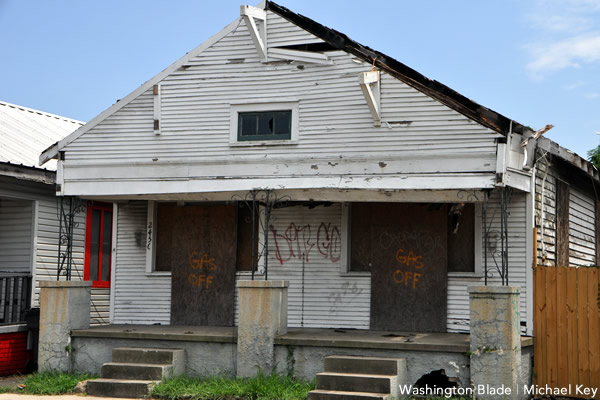
Several homes remain shuttered in New Orleans’ Upper Ninth Ward nine years after Katrina. (Washington Blade photo by Michael Key)
Damage from Katrina remains clearly visible in many areas of Louisiana and Mississippi.
Concrete slabs from oceanfront homes that had been along U.S. Highway 90 between Gulfport and Biloxi are clearly visible. Pine trees along Interstate 10 between New Orleans and the Mississippi Gulf Coast that Katrina damaged remain.
A number of damaged homes with large orange X’s spray-painted onto them remain along North Claiborne Avenue in the Upper Ninth Ward. Dozens of overgrown lots in the Lower Ninth Ward where houses had been before Katrina remain vacant.
The outrage that local, state and federal authorities faced over their response to Katrina also remains in New Orleans.
A dog house built outside the Lower Ninth Ward headquarters of Common Ground Relief — an organization that rebuilds homes and restores wetlands in the neighborhood and offers a variety of legal and other services to New Orleanians — has the acronym for the Federal Emergency Management Agency written on it. Weeks recalled homeowners throughout the city expressed their frustration with FEMA’s post-Katrina response on broken refrigerators — many of which contained liquefied meat she said smelled like “dead people” because of the lack of air conditioning — they duct-taped and placed on the street outside their homes to be picked up.
“People wrote on them, ‘FEMA inside, do not open,’” she said. “We were so mad.”
Several homes along Fleur de Lis Drive in New Orleans’ Lakeview neighborhood had bright red signs in their yards that read “Fix our streets!” because the road is nearly impassible because of the water that inundated the neighborhood after the levee along the 17th Street Canal failed. The church that Jenkins and her partner, Donna Jean Loy, attend on the street was under 17’ of water during the storm.
“We’re still having problems,” Jenkins told the Blade, noting her church has been rebuilt in spite of FEMA’s promises to help.
Julie Thompson stuck her finger in her mouth as an expression of anger towards FEMA and its response to Katrina.
“It was bad,” said Williams.
Weeks is among those who noted to the Blade the federal government — and not city or state officials — funded the rebuilding effort, but they did not actually do it.
“We were so angry at the response of the first two weeks,” she said. “After that I can tell you if it wouldn’t be for the people themselves who live here and volunteers this city would not be rebuilt.”
Mississippi advocates said their state’s response to Katrina was far better than that of then-Louisiana Gov. Kathleen Blanco and then-New Orleans Mayor Ray Nagin.
John Perkins of Waveland, Miss., who was born a month after Hurricane Camille devastated his hometown in 1969, noted that then-Mississippi Gov. Haley Barbour had connections with federal officials in D.C. because he chaired the Republican National Committee from 1993-1997.
“People have a lot to say about Haley Barbour, but he did a good job with that,” said Perkins. “It’s probably one of the things I’m most proud of him about.”
Crump echoed Perkins.
“The state’s response went well,” she said. “They did everything they could for the storm.”
Crump told the Blade that FEMA “responded well,” but she feels people who “should have received some type of assistance from” the agency didn’t receive it. She said many people were unable to navigate the red tape in order to receive federal funds to rebuild their homes and other services.
“A lot of people don’t understand complex processes like that,” said Crump.
Activists remain united after Katrina
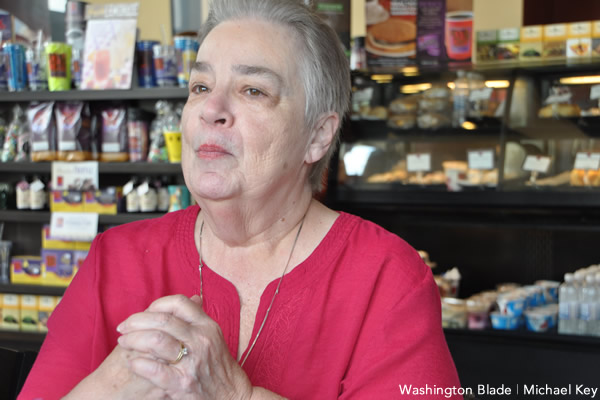
Julie Thompson, co-president of PFLAG New Orleans (Washington Blade photo by Michael Key)
The advocates with whom the Blade spoke said Katrina galvanized the LGBT community in a way that continues to this day.
The National AIDS Fund invited HIV/AIDS service providers from Louisiana and Mississippi to D.C. after the storm so they could meet with federal agencies, foundations and other non-profits that could provide them with post-hurricane assistance. Kathryn Garner, executive director of AIDS Services Coalition in Hattiesburg, Miss., told the Blade during a telephone interview earlier this month that local pharmacies did “extraordinary things” after Katrina to try to ensure people with the virus received their medications.
Someone broke into her organization’s clinic following the storm and “stole everything.”
“Whether they were local pharmacies or national chains, they all worked together,” said Garner.
Health Services Center, an HIV/AIDS service organization in Anniston, Ala., offered housing and office space to Weeks, her staff and clients after she e-mailed the Department of Housing and Urban Development from the campground to which they had evacuated from New Orleans.
They remained in Northeastern Alabama for seven months.
“They went overboard to help us,” Weeks told the Blade.
Representatives from Human Rights Campaign, PFLAG New Orleans, the New Orleans AIDS Task Force, the LGBT Community Center of New Orleans and other local and regional LGBT advocacy groups in Louisiana took part in weekly conference calls after the storm.
Tim Hornbeck of the Forum for Equality, a statewide LGBT advocacy group based in New Orleans, organized the calls.
“We would make plans for what we were going to do when we got home,” Julie Thompson told the Blade. “We were afraid since everybody was everywhere that the community was going to break apart and we needed to keep together. If we didn’t keep together, than how could we even have a community.”
Julie Thompson and the four other members of the PFLAG New Orleans Board of Directors returned to the city roughly six weeks after Katrina made landfall.
The National Youth Advocacy Coalition and COLAGE gave PFLAG New Orleans $25,000 to distribute among young people who had been left homeless because of the storm. The advocates decided to meet at the LGBT Community Center of New Orleans to determine how to distribute the money, but there was no electricity.
“We had to climb through a hole in the fence and go over garbage and go in there to this cold room in the winter and we met there every week,” recalled Julie Thompson. “Finally we decided, you know we need to get a coalition going that doesn’t meet under these circumstances, so then we met in a bar because this is New Orleans, okay… and we invited a lot of people. Everybody could share their stories, but we wanted to know what was going on with everybody so that we could support each other.”
Julie Thompson — who once attended Southern Decadence with her gay son who passed away from a stroke in 2008 during Hurricane Isaac — told the Blade that people who attended the annual New Orleans AIDS Walk in September 2006 noted the camaraderie of the local LGBT community.
“We know because of what happened to us, we as a community know that if we don’t have each other, we don’t have anything,” she said. “I’m a straight ally, but I know the importance of it and we have to keep it together.”
A similar situation played out in Mississippi.
Equality Mississippi, a fledgling statewide LGBT advocacy group, offered assistance to LGBT people on the coast after Katrina. The Union for Reform Judaism contributed $10,000 to these efforts.
“After Katrina everybody was helping everybody with anything you needed,” Perkins told the Blade. “There wasn’t a question after that.”
Perkins, who co-founded the Mississippi Gulf Coast Rainbow Center with White, said one of the reasons they decided to create the group is because he noted most of the LGBT people who lived in the area were “cut-off and weren’t able to connect with each other” because the bars were closed.
“That’s usually around here where everybody congregates because there really isn’t anything else, which is one reason why we started the page and wanted to get the community center going so there is an actual place for people to go to,” said Perkins. “That’s what we’re hoping to get to further down the line as we get bigger and get more money is to be able to build it.”
Crump, who moved to the Mississippi Gulf Coast in 2003 from Jackson, the state capital, told the Blade she was determined to return to Gulfport and to the South Mississippi AIDS Task Force after Katrina.
“I had made Gulfport my home,” she said. “I decided to return and continue to work in the fight against HIV and AIDS and continue to work with the clients.”
Some advocates along the Gulf Coast are even able to maintain a sense of humor about Katrina and its lingering effects.
Julie Thompson recalled slipping twice in the mud outside of the building of the New Orleans City Park campus of Delgado Community College where she worked. An adjacent structure collapsed during the hurricane because of the flooding.
She lay in the mud in the rain before she was finally able to walk to her car, call her husband and tell him they were not going to be able to go out for dinner.
“Sometimes you have to just lay in the mud and then you can get up and start over again,” she said. “That’s the way New Orleans was. We lay in the mud and then we finally got up and started over again. Now we’re making for a better, stronger everything.”
homepage news
Honoring the legacy of New Orleans’ 1973 UpStairs Lounge fire
Why the arson attack that killed 32 gay men still resonates 50 years later
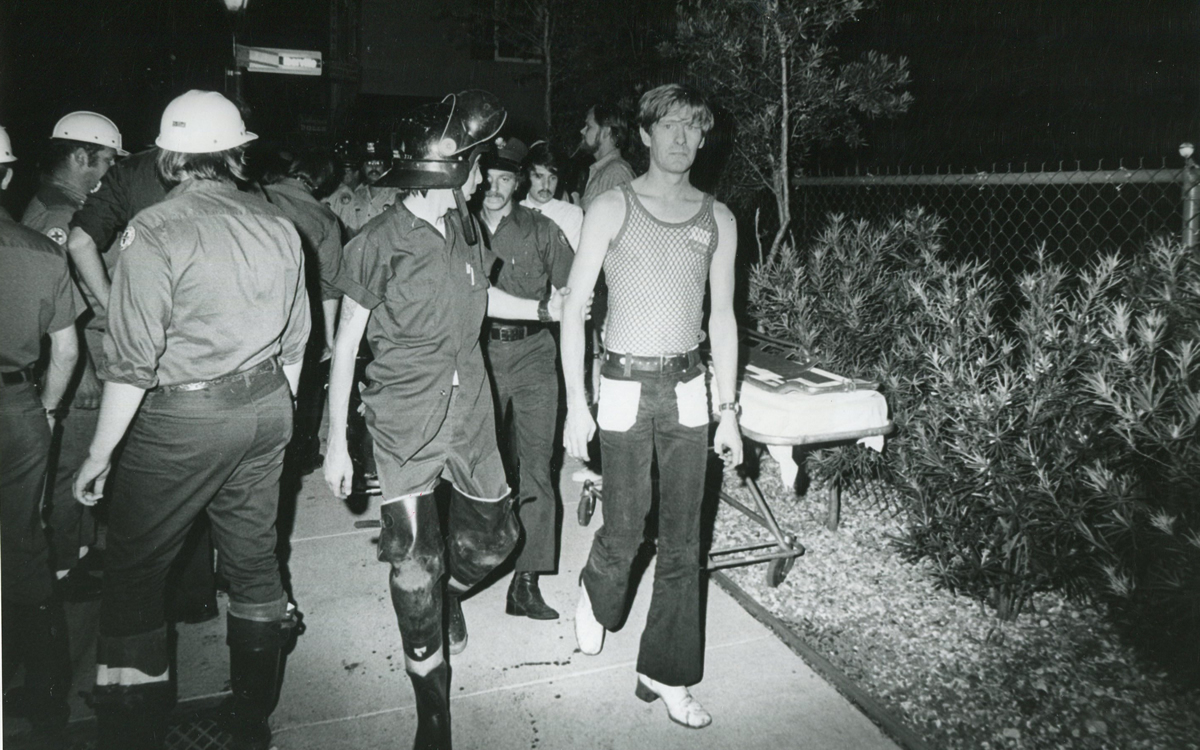
On June 23 of last year, I held the microphone as a gay man in the New Orleans City Council Chamber and related a lost piece of queer history to the seven council members. I told this story to disabuse all New Orleanians of the notion that silence and accommodation, in the face of institutional and official failures, are a path to healing.
The story I related to them began on a typical Sunday night at a second-story bar on the fringe of New Orleans’ French Quarter in 1973, where working-class men would gather around a white baby grand piano and belt out the lyrics to a song that was the anthem of their hidden community, “United We Stand” by the Brotherhood of Man.
“United we stand,” the men would sing together, “divided we fall” — the words epitomizing the ethos of their beloved UpStairs Lounge bar, an egalitarian free space that served as a forerunner to today’s queer safe havens.
Around that piano in the 1970s Deep South, gays and lesbians, white and Black queens, Christians and non-Christians, and even early gender minorities could cast aside the racism, sexism, and homophobia of the times to find acceptance and companionship for a moment.
For regulars, the UpStairs Lounge was a miracle, a small pocket of acceptance in a broader world where their very identities were illegal.
On the Sunday night of June 24, 1973, their voices were silenced in a murderous act of arson that claimed 32 lives and still stands as the deadliest fire in New Orleans history — and the worst mass killing of gays in 20th century America.
As 13 fire companies struggled to douse the inferno, police refused to question the chief suspect, even though gay witnesses identified and brought the soot-covered man to officers idly standing by. This suspect, an internally conflicted gay-for-pay sex worker named Rodger Dale Nunez, had been ejected from the UpStairs Lounge screaming the word “burn” minutes before, but New Orleans police rebuffed the testimony of fire survivors on the street and allowed Nunez to disappear.
As the fire raged, police denigrated the deceased to reporters on the street: “Some thieves hung out there, and you know this was a queer bar.”
For days afterward, the carnage met with official silence. With no local gay political leaders willing to step forward, national Gay Liberation-era figures like Rev. Troy Perry of the Metropolitan Community Church flew in to “help our bereaved brothers and sisters” — and shatter officialdom’s code of silence.
Perry broke local taboos by holding a press conference as an openly gay man. “It’s high time that you people, in New Orleans, Louisiana, got the message and joined the rest of the Union,” Perry said.
Two days later, on June 26, 1973, as families hesitated to step forward to identify their kin in the morgue, UpStairs Lounge owner Phil Esteve stood in his badly charred bar, the air still foul with death. He rebuffed attempts by Perry to turn the fire into a call for visibility and progress for homosexuals.
“This fire had very little to do with the gay movement or with anything gay,” Esteve told a reporter from The Philadelphia Inquirer. “I do not want my bar or this tragedy to be used to further any of their causes.”
Conspicuously, no photos of Esteve appeared in coverage of the UpStairs Lounge fire or its aftermath — and the bar owner also remained silent as he witnessed police looting the ashes of his business.
“Phil said the cash register, juke box, cigarette machine and some wallets had money removed,” recounted Esteve’s friend Bob McAnear, a former U.S. Customs officer. “Phil wouldn’t report it because, if he did, police would never allow him to operate a bar in New Orleans again.”
The next day, gay bar owners, incensed at declining gay bar traffic amid an atmosphere of anxiety, confronted Perry at a clandestine meeting. “How dare you hold your damn news conferences!” one business owner shouted.
Ignoring calls for gay self-censorship, Perry held a 250-person memorial for the fire victims the following Sunday, July 1, culminating in mourners defiantly marching out the front door of a French Quarter church into waiting news cameras. “Reverend Troy Perry awoke several sleeping giants, me being one of them,” recalled Charlene Schneider, a lesbian activist who walked out of that front door with Perry.
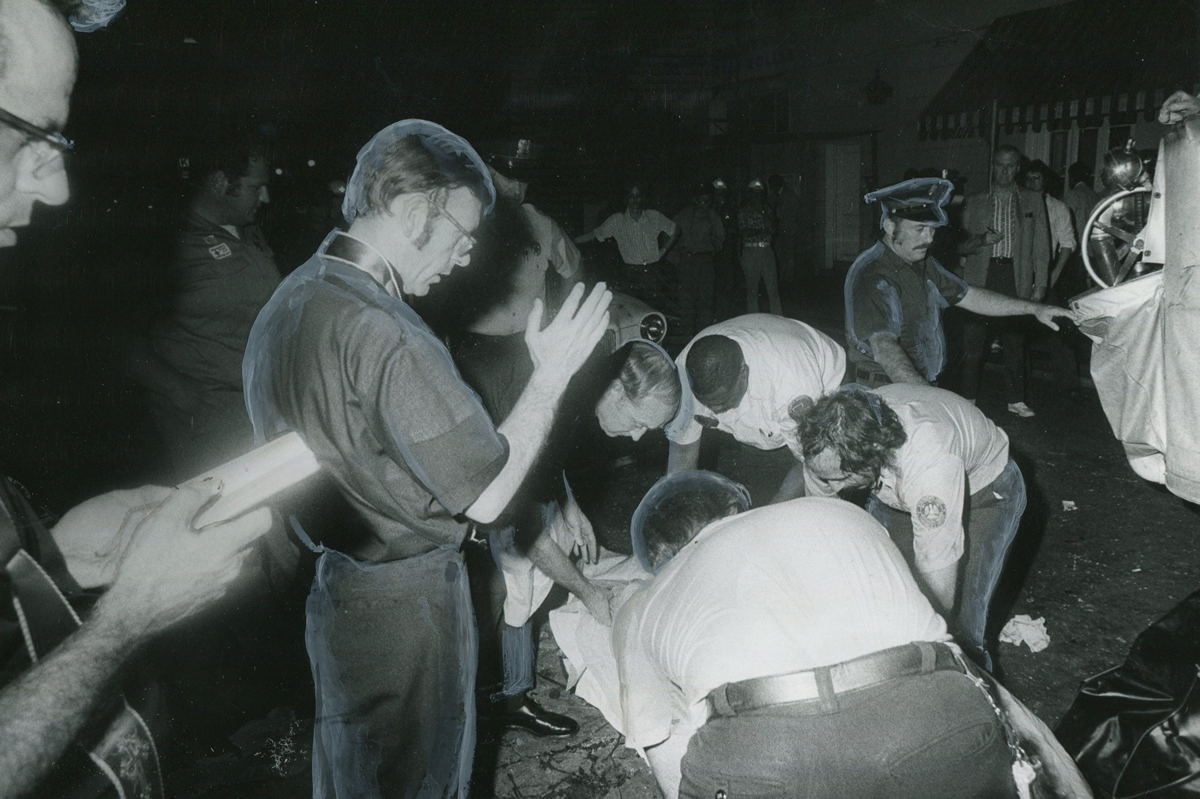
Esteve doubted the UpStairs Lounge story’s capacity to rouse gay political fervor. As the coroner buried four of his former patrons anonymously on the edge of town, Esteve quietly collected at least $25,000 in fire insurance proceeds. Less than a year later, he used the money to open another gay bar called the Post Office, where patrons of the UpStairs Lounge — some with visible burn scars — gathered but were discouraged from singing “United We Stand.”
New Orleans cops neglected to question the chief arson suspect and closed the investigation without answers in late August 1973. Gay elites in the city’s power structure began gaslighting the mourners who marched with Perry into the news cameras, casting suspicion on their memories and re-characterizing their moment of liberation as a stunt.
When a local gay journalist asked in April 1977, “Where are the gay activists in New Orleans?,” Esteve responded that there were none, because none were needed. “We don’t feel we’re discriminated against,” Esteve said. “New Orleans gays are different from gays anywhere else… Perhaps there is some correlation between the amount of gay activism in other cities and the degree of police harassment.”
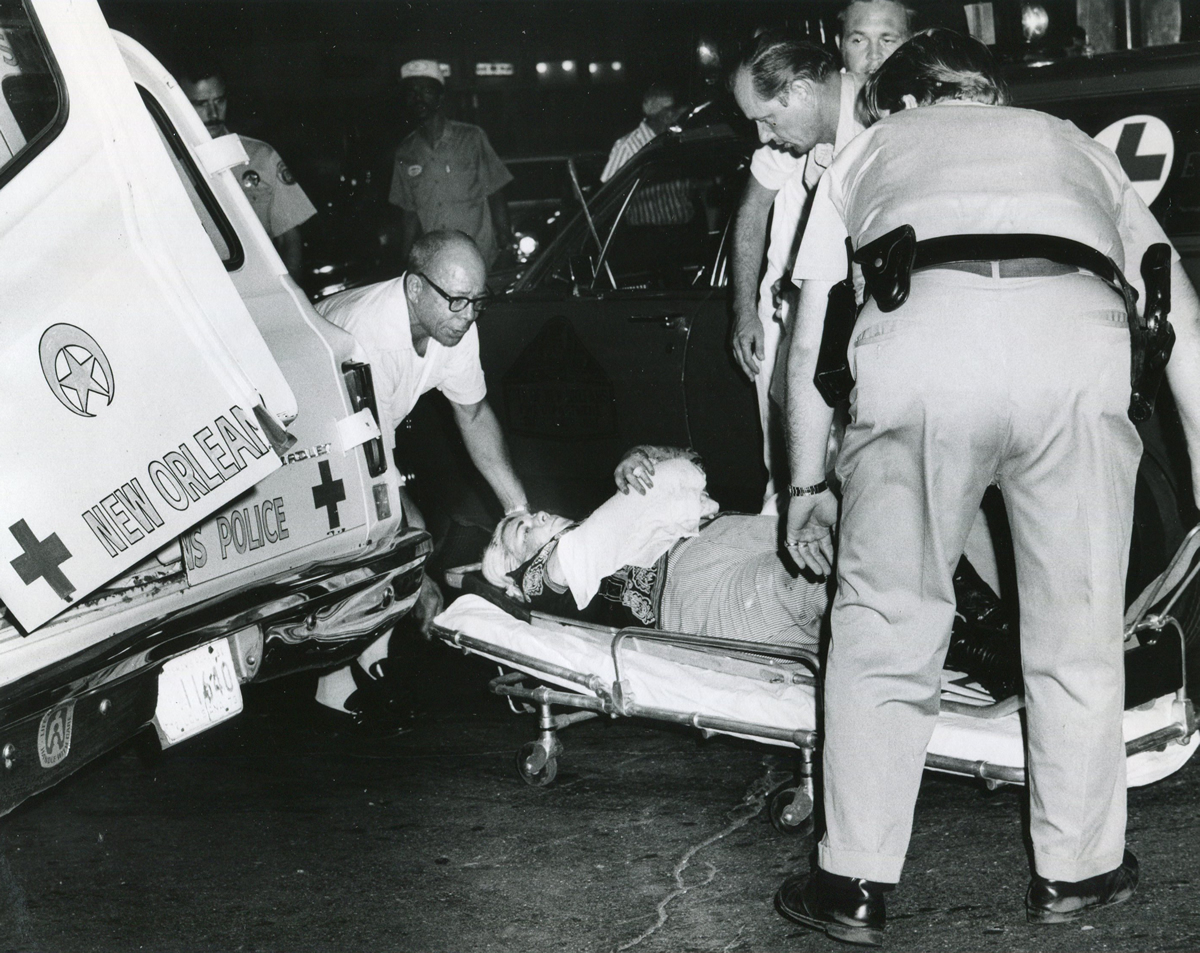
An attitude of nihilism and disavowal descended upon the memory of the UpStairs Lounge victims, goaded by Esteve and fellow gay entrepreneurs who earned their keep via gay patrons drowning their sorrows each night instead of protesting the injustices that kept them drinking.
Into the 1980s, the story of the UpStairs Lounge all but vanished from conversation — with the exception of a few sanctuaries for gay political debate such as the local lesbian bar Charlene’s, run by the activist Charlene Schneider.
By 1988, the 15th anniversary of the fire, the UpStairs Lounge narrative comprised little more than a call for better fire codes and indoor sprinklers. UpStairs Lounge survivor Stewart Butler summed it up: “A tragedy that, as far as I know, no good came of.”
Finally, in 1991, at Stewart Butler and Charlene Schneider’s nudging, the UpStairs Lounge story became aligned with the crusade of liberated gays and lesbians seeking equal rights in Louisiana. The halls of power responded with intermittent progress. The New Orleans City Council, horrified by the story but not yet ready to take its look in the mirror, enacted an anti-discrimination ordinance protecting gays and lesbians in housing, employment, and public accommodations that Dec. 12 — more than 18 years after the fire.
“I believe the fire was the catalyst for the anger to bring us all to the table,” Schneider told The Times-Picayune, a tacit rebuke to Esteve’s strategy of silent accommodation. Even Esteve seemed to change his stance with time, granting a full interview with the first UpStairs Lounge scholar Johnny Townsend sometime around 1989.
Most of the figures in this historic tale are now deceased. What’s left is an enduring story that refused to go gently. The story now echoes around the world — a musical about the UpStairs Lounge fire recently played in Tokyo, translating the gay underworld of the 1973 French Quarter for Japanese audiences.
When I finished my presentation to the City Council last June, I looked up to see the seven council members in tears. Unanimously, they approved a resolution acknowledging the historic failures of city leaders in the wake of the UpStairs Lounge fire.
Council members personally apologized to UpStairs Lounge families and survivors seated in the chamber in a symbolic act that, though it could not bring back those who died, still mattered greatly to those whose pain had been denied, leaving them to grieve alone. At long last, official silence and indifference gave way to heartfelt words of healing.
The way Americans remember the past is an active, ongoing process. Our collective memory is malleable, but it matters because it speaks volumes about our maturity as a people, how we acknowledge the past’s influence in our lives, and how it shapes the examples we set for our youth. Do we grapple with difficult truths, or do we duck accountability by defaulting to nostalgia and bluster? Or worse, do we simply ignore the past until it fades into a black hole of ignorance and indifference?
I believe that a factual retelling of the UpStairs Lounge tragedy — and how, 50 years onward, it became known internationally — resonates beyond our current divides. It reminds queer and non-queer Americans that ignoring the past holds back the present, and that silence is no cure for what ails a participatory nation.
Silence isolates. Silence gaslights and shrouds. It preserves the power structures that scapegoat the disempowered.
Solidarity, on the other hand, unites. Solidarity illuminates a path forward together. Above all, solidarity transforms the downtrodden into a resounding chorus of citizens — in the spirit of voices who once gathered ‘round a white baby grand piano and sang, joyfully and loudly, “United We Stand.”
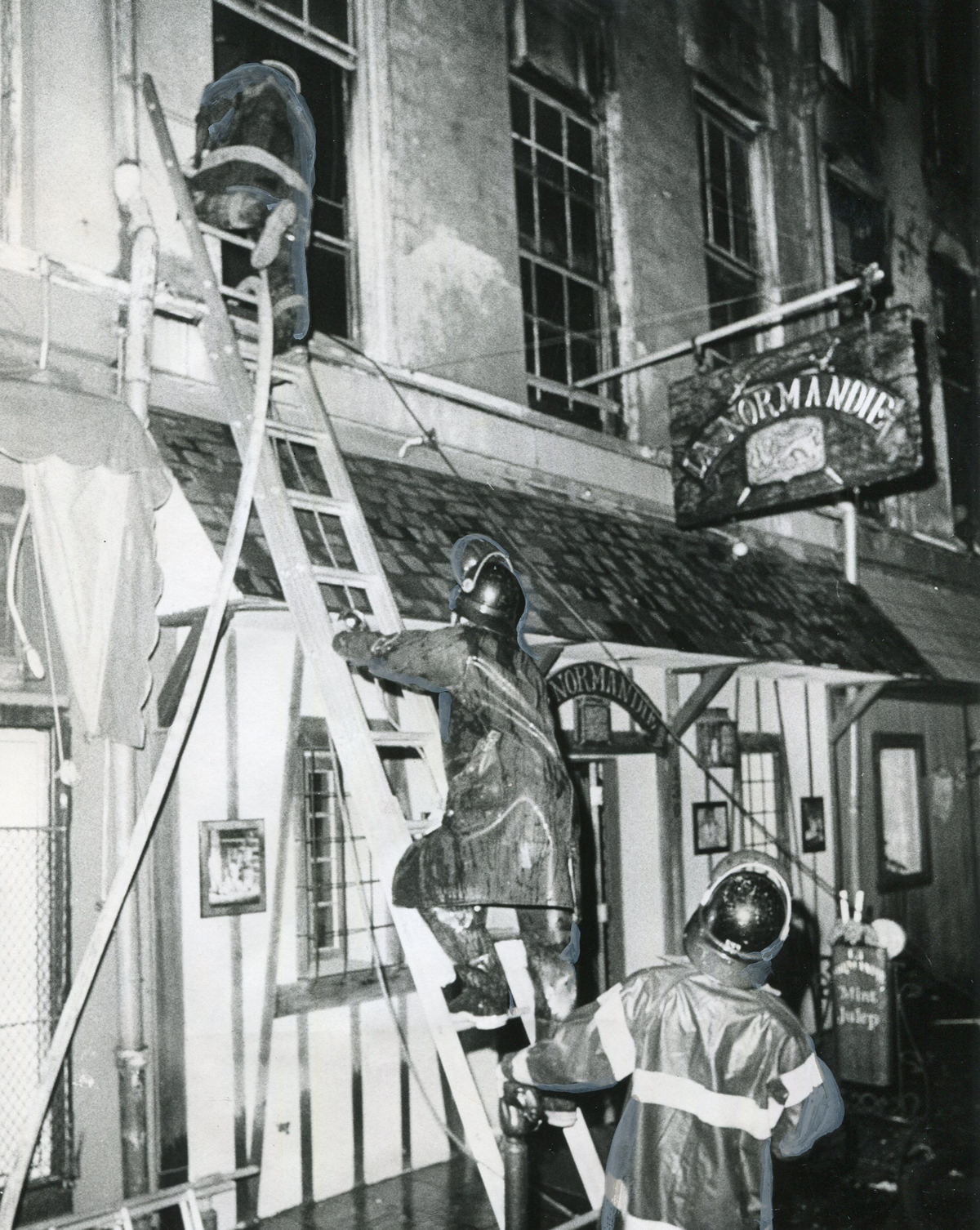
Robert W. Fieseler is a New Orleans-based journalist and the author of “Tinderbox: the Untold Story of the Up Stairs Lounge Fire and the Rise of Gay Liberation.”
homepage news
New Supreme Court term includes critical LGBTQ case with ‘terrifying’ consequences
Business owner seeks to decline services for same-sex weddings
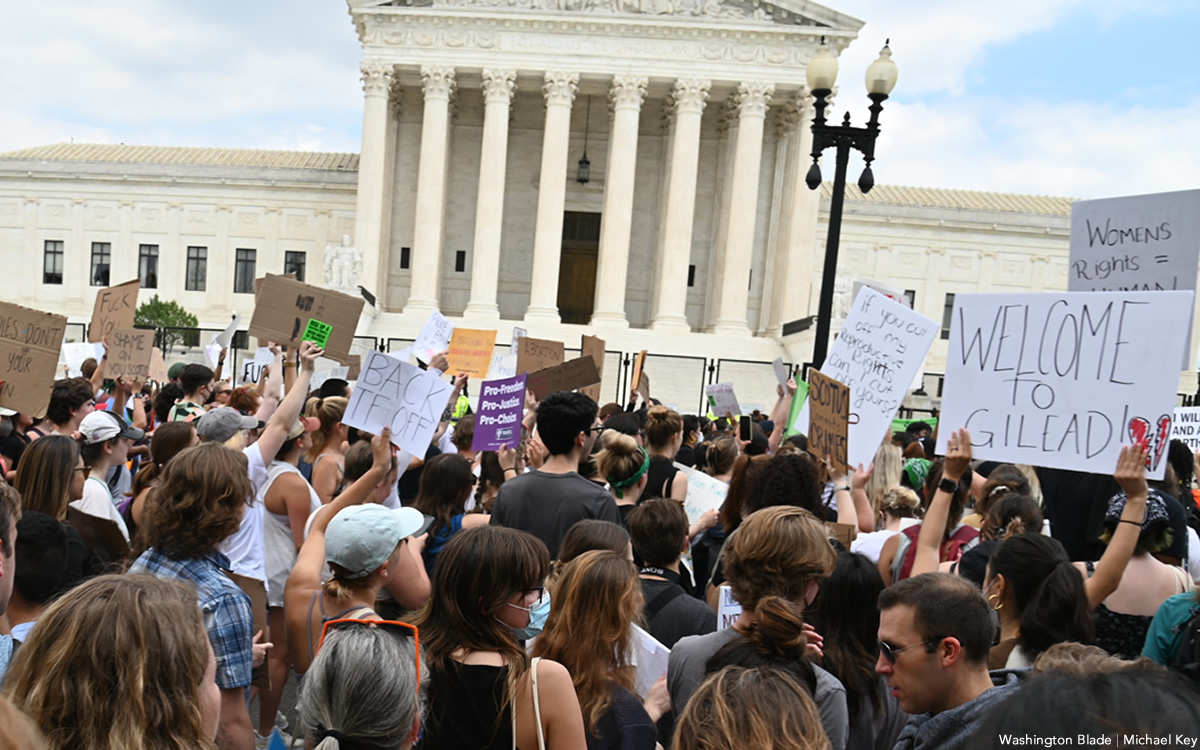
The U.S. Supreme Court, after a decision overturning Roe v. Wade that still leaves many reeling, is starting a new term with justices slated to revisit the issue of LGBTQ rights.
In 303 Creative v. Elenis, the court will return to the issue of whether or not providers of custom-made goods can refuse service to LGBTQ customers on First Amendment grounds. In this case, the business owner is Lorie Smith, a website designer in Colorado who wants to opt out of providing her graphic design services for same-sex weddings despite the civil rights law in her state.
Jennifer Pizer, acting chief legal officer of Lambda Legal, said in an interview with the Blade, “it’s not too much to say an immeasurably huge amount is at stake” for LGBTQ people depending on the outcome of the case.
“This contrived idea that making custom goods, or offering a custom service, somehow tacitly conveys an endorsement of the person — if that were to be accepted, that would be a profound change in the law,” Pizer said. “And the stakes are very high because there are no practical, obvious, principled ways to limit that kind of an exception, and if the law isn’t clear in this regard, then the people who are at risk of experiencing discrimination have no security, no effective protection by having a non-discrimination laws, because at any moment, as one makes their way through the commercial marketplace, you don’t know whether a particular business person is going to refuse to serve you.”
The upcoming arguments and decision in the 303 Creative case mark a return to LGBTQ rights for the Supreme Court, which had no lawsuit to directly address the issue in its previous term, although many argued the Dobbs decision put LGBTQ rights in peril and threatened access to abortion for LGBTQ people.
And yet, the 303 Creative case is similar to other cases the Supreme Court has previously heard on the providers of services seeking the right to deny services based on First Amendment grounds, such as Masterpiece Cakeshop and Fulton v. City of Philadelphia. In both of those cases, however, the court issued narrow rulings on the facts of litigation, declining to issue sweeping rulings either upholding non-discrimination principles or First Amendment exemptions.
Pizer, who signed one of the friend-of-the-court briefs in opposition to 303 Creative, said the case is “similar in the goals” of the Masterpiece Cakeshop litigation on the basis they both seek exemptions to the same non-discrimination law that governs their business, the Colorado Anti-Discrimination Act, or CADA, and seek “to further the social and political argument that they should be free to refuse same-sex couples or LGBTQ people in particular.”
“So there’s the legal goal, and it connects to the social and political goals and in that sense, it’s the same as Masterpiece,” Pizer said. “And so there are multiple problems with it again, as a legal matter, but also as a social matter, because as with the religion argument, it flows from the idea that having something to do with us is endorsing us.”
One difference: the Masterpiece Cakeshop litigation stemmed from an act of refusal of service after owner, Jack Phillips, declined to make a custom-made wedding cake for a same-sex couple for their upcoming wedding. No act of discrimination in the past, however, is present in the 303 Creative case. The owner seeks to put on her website a disclaimer she won’t provide services for same-sex weddings, signaling an intent to discriminate against same-sex couples rather than having done so.
As such, expect issues of standing — whether or not either party is personally aggrieved and able bring to a lawsuit — to be hashed out in arguments as well as whether the litigation is ripe for review as justices consider the case. It’s not hard to see U.S. Chief Justice John Roberts, who has sought to lead the court to reach less sweeping decisions (sometimes successfully, and sometimes in the Dobbs case not successfully) to push for a decision along these lines.
Another key difference: The 303 Creative case hinges on the argument of freedom of speech as opposed to the two-fold argument of freedom of speech and freedom of religious exercise in the Masterpiece Cakeshop litigation. Although 303 Creative requested in its petition to the Supreme Court review of both issues of speech and religion, justices elected only to take up the issue of free speech in granting a writ of certiorari (or agreement to take up a case). Justices also declined to accept another question in the petition request of review of the 1990 precedent in Smith v. Employment Division, which concluded states can enforce neutral generally applicable laws on citizens with religious objections without violating the First Amendment.
Representing 303 Creative in the lawsuit is Alliance Defending Freedom, a law firm that has sought to undermine civil rights laws for LGBTQ people with litigation seeking exemptions based on the First Amendment, such as the Masterpiece Cakeshop case.
Kristen Waggoner, president of Alliance Defending Freedom, wrote in a Sept. 12 legal brief signed by her and other attorneys that a decision in favor of 303 Creative boils down to a clear-cut violation of the First Amendment.
“Colorado and the United States still contend that CADA only regulates sales transactions,” the brief says. “But their cases do not apply because they involve non-expressive activities: selling BBQ, firing employees, restricting school attendance, limiting club memberships, and providing room access. Colorado’s own cases agree that the government may not use public-accommodation laws to affect a commercial actor’s speech.”
Pizer, however, pushed back strongly on the idea a decision in favor of 303 Creative would be as focused as Alliance Defending Freedom purports it would be, arguing it could open the door to widespread discrimination against LGBTQ people.
“One way to put it is art tends to be in the eye of the beholder,” Pizer said. “Is something of a craft, or is it art? I feel like I’m channeling Lily Tomlin. Remember ‘soup and art’? We have had an understanding that whether something is beautiful or not is not the determining factor about whether something is protected as artistic expression. There’s a legal test that recognizes if this is speech, whose speech is it, whose message is it? Would anyone who was hearing the speech or seeing the message understand it to be the message of the customer or of the merchants or craftsmen or business person?”
Despite the implications in the case for LGBTQ rights, 303 Creative may have supporters among LGBTQ people who consider themselves proponents of free speech.
One joint friend-of-the-court brief before the Supreme Court, written by Dale Carpenter, a law professor at Southern Methodist University who’s written in favor of LGBTQ rights, and Eugene Volokh, a First Amendment legal scholar at the University of California, Los Angeles, argues the case is an opportunity to affirm the First Amendment applies to goods and services that are uniquely expressive.
“Distinguishing expressive from non-expressive products in some contexts might be hard, but the Tenth Circuit agreed that Smith’s product does not present a hard case,” the brief says. “Yet that court (and Colorado) declined to recognize any exemption for products constituting speech. The Tenth Circuit has effectively recognized a state interest in subjecting the creation of speech itself to antidiscrimination laws.”
Oral arguments in the case aren’t yet set, but may be announced soon. Set to defend the state of Colorado and enforcement of its non-discrimination law in the case is Colorado Solicitor General Eric Reuel Olson. Just this week, the U.S. Supreme Court announced it would grant the request to the U.S. solicitor general to present arguments before the justices on behalf of the Biden administration.
With a 6-3 conservative majority on the court that has recently scrapped the super-precedent guaranteeing the right to abortion, supporters of LGBTQ rights may think the outcome of the case is all but lost, especially amid widespread fears same-sex marriage would be next on the chopping block. After the U.S. Tenth Circuit Court of Appeals ruled against 303 Creative in the lawsuit, the simple action by the Supreme Court to grant review in the lawsuit suggests they are primed to issue a reversal and rule in favor of the company.
Pizer, acknowledging the call to action issued by LGBTQ groups in the aftermath of the Dobbs decision, conceded the current Supreme Court issuing the ruling in this case is “a terrifying prospect,” but cautioned the issue isn’t so much the makeup of the court but whether or not justices will continue down the path of abolishing case law.
“I think the question that we’re facing with respect to all of the cases or at least many of the cases that are in front of the court right now, is whether this court is going to continue on this radical sort of wrecking ball to the edifice of settled law and seemingly a goal of setting up whole new structures of what our basic legal principles are going to be. Are we going to have another term of that?” Pizer said. “And if so, that’s terrifying.”
homepage news
Kelley Robinson, a Black, queer woman, named president of Human Rights Campaign
Progressive activist a veteran of Planned Parenthood Action Fund
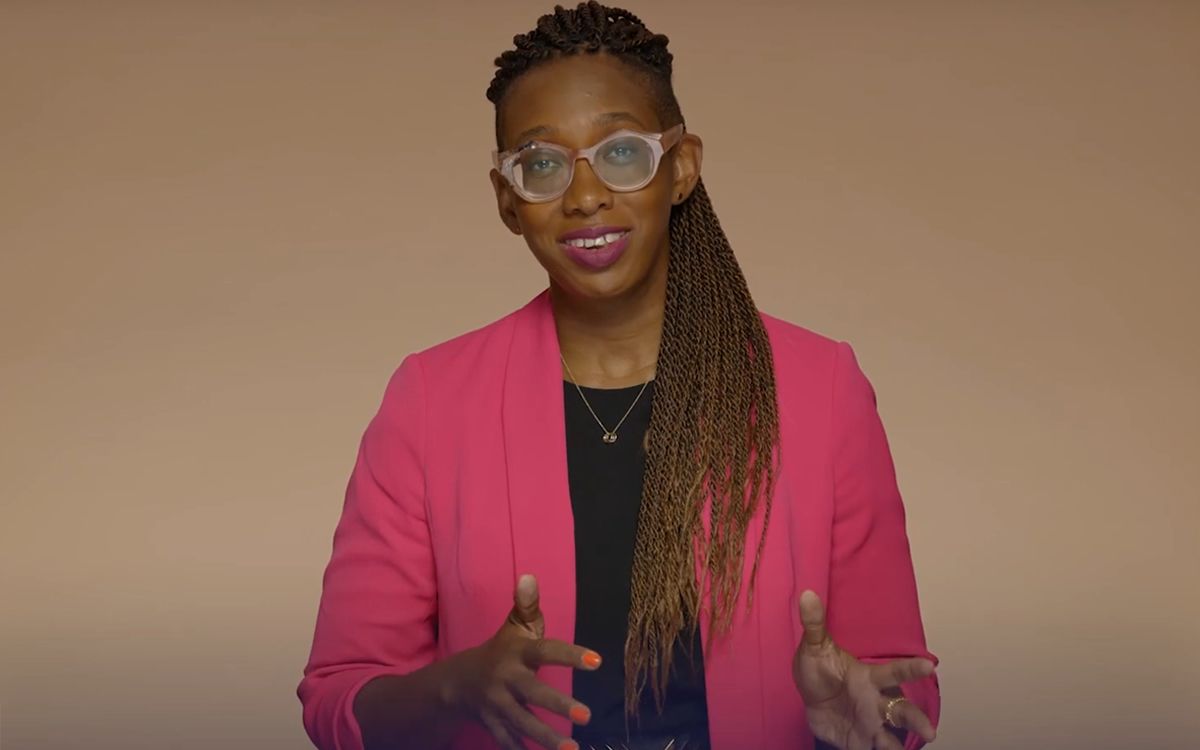
Kelley Robinson, a Black, queer woman and veteran of Planned Parenthood Action Fund, is to become the next president of the Human Rights Campaign, the nation’s leading LGBTQ group announced on Tuesday.
Robinson is set to become the ninth president of the Human Rights Campaign after having served as executive director of Planned Parenthood Action Fund and more than 12 years of experience as a leader in the progressive movement. She’ll be the first Black, queer woman to serve in that role.
“I’m honored and ready to lead HRC — and our more than three million member-advocates — as we continue working to achieve equality and liberation for all Lesbian, Gay, Bisexual, Transgender, and Queer people,” Robinson said. “This is a pivotal moment in our movement for equality for LGBTQ+ people. We, particularly our trans and BIPOC communities, are quite literally in the fight for our lives and facing unprecedented threats that seek to destroy us.”
The next Human Rights Campaign president is named as Democrats are performing well in polls in the mid-term elections after the U.S. Supreme Court overturned Roe v. Wade, leaving an opening for the LGBTQ group to play a key role amid fears LGBTQ rights are next on the chopping block.
“The overturning of Roe v. Wade reminds us we are just one Supreme Court decision away from losing fundamental freedoms including the freedom to marry, voting rights, and privacy,” Robinson said. “We are facing a generational opportunity to rise to these challenges and create real, sustainable change. I believe that working together this change is possible right now. This next chapter of the Human Rights Campaign is about getting to freedom and liberation without any exceptions — and today I am making a promise and commitment to carry this work forward.”
The Human Rights Campaign announces its next president after a nearly year-long search process after the board of directors terminated its former president Alphonso David when he was ensnared in the sexual misconduct scandal that led former New York Gov. Andrew Cuomo to resign. David has denied wrongdoing and filed a lawsuit against the LGBTQ group alleging racial discrimination.
